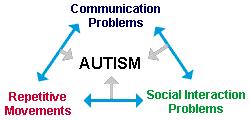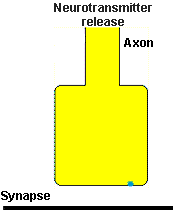Neuroscience For Kids
Autism Spectrum Disorder / Autism
A Case Study
 Fred's parents were concerned. Fred was two and a half years old, but
had not begun to talk. He didn't babble like other children his age. Fred
did not make eye contact, but his vision seemed fine. He loved watching
his own hands. He could sit for hours watching his hands move back and
forth.
Fred's parents were concerned. Fred was two and a half years old, but
had not begun to talk. He didn't babble like other children his age. Fred
did not make eye contact, but his vision seemed fine. He loved watching
his own hands. He could sit for hours watching his hands move back and
forth.
Fred was diagnosed with autism, a neurological disorder that disrupts normal development. Some children with autism can attend school with children their own age; others need special care.
The Symptoms
Autism is classified as a pervasive developmental disorder. The "pervasive" part of the name implies that the disorder is serious, or that it affects many areas of development. Symptoms vary greatly from person to person. People with autism may appear to daydream constantly or be unaware of people around them. Most children with autism prefer to play by themselves, and treat other people like furniture. The major symptoms of autism include:
- Communication Problems: Many people with autism are uncommunicative - they will not speak, gesture, or make facial expressions. When they do speak, the speech may be in a sing-song pattern or monotone (no variation in pitch, like playing a single note on an instrument). Other people with autism may talk at length with no regard to what another person says or does.
- Repetitive Motions: Most people with autism enjoy repetitive motions, such as spinning objects, running water, or sniffing objects. A sense of routine is very important, and it can be extremely upsetting to them when part of their routine is changed. This could be something as trivial as changing the route to the grocery store or moving an item within the house.
- Problems with Social Interactions: People with autism have trouble interpreting other people's facial expressions. Most of the time they will not make eye contact with others and have trouble making friends. Some people with autism are hypersensitive to sound and may get very upset when they hear sirens or dogs barking. Others are fascinated by faint noises such as the ticking of a watch. To some, bright lights are distressing, while others will stare at bright lights for hours. Many people with autism can not stand light touch: scratchy clothing could be unbearable. Others seem immune to pain and may hurt themselves. Mood swings are common.

The Cause of Autism is Unknown
It was once thought that poor parenting caused autism. This is definitely not true. Although the cause of autism is unclear, it is known that genetics do play a role. The disorder is seen often in identical twins: different studies have shown that if one identical twin has autism then there is a 63-98% chance that the other twin will have it. For non-identical twins (also called fraternal or dizygotic twins), the chance is between 0-10% that both twins will develop autism. The chance that siblings will be affected by autism is about 3%.
Chance that both people will develop autism:
 63-98% Identical Twins |
 0-10% Fraternal Twins |
 3% Siblings |
Autism appears to be associated with other chromosomal abnormalities, such as Fragile X syndrome or brain abnormalities such as congenital rubella syndrome. A large number of people with these disorders are also diagnosed with autism. Furthermore, complicated births, such as difficult pregnancies, labor, or delivery may to contribute to the disorder.
Diagnosis
![]() Autism is a behaviorally defined syndrome. There
is no simple test for it. Usually parents notice that their child is not
developing in the same way as other children the same age. A physician can
perform a psychiatric exam, ruling out other disorders such as
schizophrenia, selective mutism (when the child chooses not to speak but
can speak if he wanted to), or cognitive disability, to name a few.
Other tests examine language skills. When all test results are examined,
a physician can make a diagnosis.
Autism is a behaviorally defined syndrome. There
is no simple test for it. Usually parents notice that their child is not
developing in the same way as other children the same age. A physician can
perform a psychiatric exam, ruling out other disorders such as
schizophrenia, selective mutism (when the child chooses not to speak but
can speak if he wanted to), or cognitive disability, to name a few.
Other tests examine language skills. When all test results are examined,
a physician can make a diagnosis.
Treatment
Although symptoms in children may lessen with age, autism is a lifelong disorder. Some people with autism will remain in institutionalized care and approximately 50% will remain without the ability to speak. Structured programs that do not allow the child to "tune out" have proved successful at helping many children gain language and some social skills. Many times children with autism will have other disorders, such as epilepsy (seizures), hyperactivity, and attention problems. Epilepsy, in particular, appears to get worse as autistic children get older.
Drugs that inhibit the reuptake of the neurotransmitter called serotonin have some success in treating patients with autism. These drugs, such as Fluoxetine, slow the reuptake of serotonin by the neuron that releases it. Therefore, serotonin stays in the synapse for a longer time.
Normal Synapse |
With Fluoxetine |
A Look at the Brain of a Person with Autism
 Brain imaging techniques, such as magnetic resonance imaging (MRI), have
been used to examine the brains of people with autism. However, results
have been inconsistent. Abnormal brain areas in people with autism
include the:
Brain imaging techniques, such as magnetic resonance imaging (MRI), have
been used to examine the brains of people with autism. However, results
have been inconsistent. Abnormal brain areas in people with autism
include the:
- Cerebellum - reduced size in parts of the cerebellum.
- Hippocampus and Amygdala - smaller volume. Also, neurons in these areas are smaller and more tightly packed (higher cell density).
- Lobes of the Cerebrum - larger size than normal.
- Ventricles - increased size.
- Caudate nucleus - reduced volume.
Quick Facts About Autism
- Autism occurs in approximately 1 out of every 59 children in the U.S. (Reference: CDC)
- Autism is the third most common developmental disorder in the U.S., affecting at least 500,000 people.
- Autism is seen more often in boys; four or five boys will have autism compared to one girl. But girls with autism are often more severely affected than boys and score lower on intelligence tests.
- Leo Kanner first described autism as the "inability to relate themselves in the ordinary way to people and situations from the beginning of life" in the 1943 paper "Autistic Disturbances of Affective Contact."
- Autism usually is seen within the first three years of life.
- Some people with autism are gifted in certain areas such as math or music.
- Autism has also been called "early infantile autism," "childhood autism," "Kanner's autism," and "pervasive developmental disorder."
References and further reading:
- American Psychiatric Association: Diagnostic Manual of Mental Disorders (DSM-IV), 4th Edition, Washington, D.C., American Psychiatric Association, 1994.
- Griffiths, D. 5-Minute Clinical Consult, Baltimore: Williams and Wilkins, Inc., 1999.
- Kaplan, H.I. and Sadock, B.J., Comprehensive Textbook of Psychiatry, 6th Edition, Baltimore: Williams and Wilkins, 1995.
- Kates, W.R. et al., Neuroanatomical and neurocognitive differences in a pair of monozygous twins discordant for strictly defined autism, Ann. Neurol., 43:782-791, 1998.
- Rapin, I. Autism in search of a home in the brain. Neurology, 52:902-904, 1999.
- Rowland, L.P., Merritt's Textbook of Neurology, 9th Edition, Malvern: Williams and Wilkins, 1995.
- Autism Information from the National Institute of Child Health and Human Development
- University of Washington Autism Center
Copyright © 1996-2020, Eric H. Chudler, University of Washington
